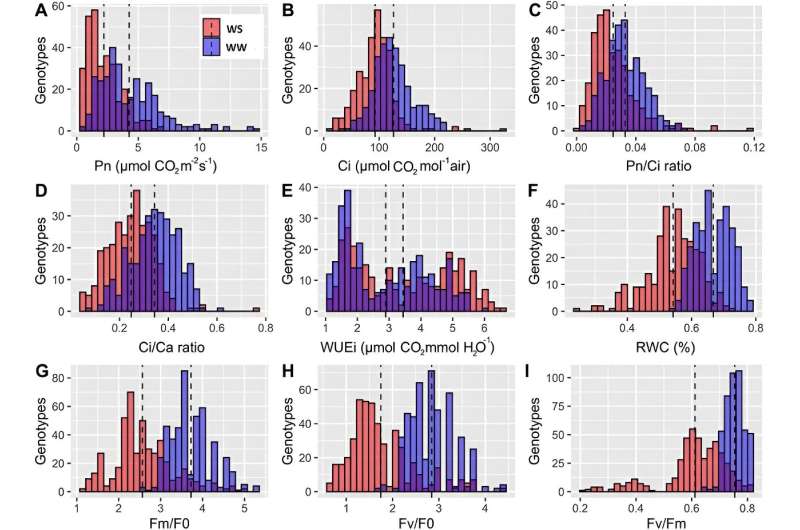This article has been reviewed according to Science X's editorial process and policies. Editors have highlighted the following attributes while ensuring the content's credibility:
fact-checked
peer-reviewed publication
proofread
Unlocking the genetic secrets of drought resilience in Persian walnuts

The walnut (Juglans regia L.), which was domesticated in ancient Persia, is a globally cultivated nut crop. With global water scarcity, walnut production is facing significant challenges due to abiotic stresses, especially drought. Photosynthesis is a key physiological mechanism involved in adaption to abiotic stresses and regulation of plant development.
Research has mainly focused on the physiological effects of drought on walnut, but the molecular mechanisms are not fully understood. Many new genomic tools have been extensively used for investigating genomic diversity and association mapping in walnut.
Persian walnut reference genome and SNP genotyping arrays have facilitated advanced genomic studies, including QTL mapping and genome-wide association studies (GWAS).
Techniques like genotyping-by-sequencing (GBS) and restriction site-associated DNA sequencing (RADseq) approaches have the potential to generate large marker datasets. However, many small effect SNP markers are always ignored and most of the genetic variants contributing to the trait remain hidden. Therefore, complementary methods like gene set enrichment analysis could provide deeper insights into the molecular mechanisms of walnut's response to drought stress.
In June 2022, Horticulture Research published a research article titled "Genome-wide association analysis and pathway enrichment provide insights into the genetic basis of photosynthetic responses to drought stress in Persian walnut."
Firstly, this research explored natural variation in photosynthetic traits utilizing 150 walnut families (1,500 seedlings) from Iran's major walnut-growing regions. They assessed under control, water-stress, and recovery conditions for 30 photosynthetic-related traits, largely categorized into two main categories (gas exchange and chlorophyll fluorescence measurements).
The results showed that high phenotypic variation among families, with most traits displaying a near-normal distribution. Significant genotypic variation was noted in both categories of photosynthetic trait across treatments, except for some gas exchange parameters (Ci and Ci/Ca under drought recovery) and chlorophyll fluorescence measurements (VI under drought, FI and FM under recovery). Most of the photosynthetic traits showed substantial reductions under drought stress. Significant correlations were observed among traits under drought conditions.
To further explore the key parameters and provide an integrated view of the relationships among traits within populations, principal component analysis (PCA) on all photosynthetic traits of the 140 families during stress was performed. The first five components (PC1–5) cumulatively explained over 90% of total variation for the photosynthetic traits across the panel under severe drought, with the first component (PC1) significantly correlated with water relation parameters and FV/FM index.
In SNP calling and population structure analysis, genomic data from 95 mother trees and 150 families were used. The Array-scored SNPs were categorized into six default groups.
PCA and population structure estimates for each set of panels genotyped through GBS, and the panels were divided into four main clusters based on geographical locations.
The Genome-Wide Association Study (GWAS) identified 198 (34%), 228 (40%) and 152 (26%) significant associations for at least one photosynthetic-related trait under all conditions using the MArray, MGBS and PGBS datasets, respectively. Then, the BLASTX results showed out of 578 and 1,543 significant and suggestive SNPs identified by GWAS.
Most of the SNPs located within or nearby the genes which were involved in the regulation of photosynthesis and drought tolerance. Gene-set enrichment and network analysis extracted genes around significant and suggestive SNPs, identifying several KEGG pathways and GO terms relevant to drought tolerance and photosynthesis. Enriched pathways were related to metabolic processes including carbohydrate metabolism, amino acid metabolism, lipid metabolism, energy metabolism and signal transduction.
Lastly, the protein-protein interactions identified hub genes involved in photosynthesis and drought response, providing insights into genetic controls of photosynthetic traits under varying conditions in Persian walnut.
In summary, these findings underscore the potential of natural photosynthetic variation in walnuts as a valuable resource for breeding and engineering more efficient photosynthesis, particularly in the context of climate change and water scarcity.
This research not only sheds light on walnut's physiological and genetic adaptation to drought but also provides a foundation for future walnut breeding programs focused on improving drought tolerance.
More information: Mohammad M Arab et al, Genome-wide association analysis and pathway enrichment provide insights into the genetic basis of photosynthetic responses to drought stress in Persian walnut, Horticulture Research (2022). DOI: 10.1093/hr/uhac124
Journal information: Horticulture Research
Provided by Plant Phenomics




















